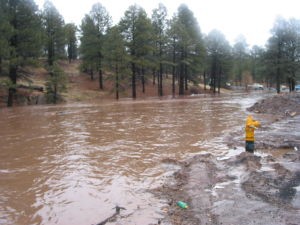AZ Daily Sun • SUZANNE ADAMS-OCKRASSA SUN STAFF REPORTER

Flooding in 2004-05 in the Rio de Flag below Sinagua Heights (AZ Daily Sun courtesy photo).
Flagstaff City Council is tired of waiting for the federal government to fund and build the Rio de Flag flood control project.
Staff presented Council with four design and cost alternatives to the U.S. Army Corps of Engineer’s plan for the project Tuesday.
The good news is a city-built project would likely be completed sooner than the Army’s plan.
The bad news is that the local project would not receive federal funding and thus likely cost local taxpayers at least $23 million more than the Army project unless other funding can be obtained.
James Duval, the city project manager, said the Army project is taking too long. The Corps estimates that it will take around 20 to 25 years to finish and the cost has increased 446 percent since the project started in 2004. The city has spent $15 million to date and struggled to get federal funding for the project for the last three years.
Staff identified four options for the project, he said. In the first option, the city could continue working with the Army Corps and depend on federal funding. In the second option, it could take federal funding and ask the Corps to allow the city to administer the project. In the third option, the city would take complete control of the project and find a way to fund it itself.
The fourth option was to abandon the project altogether.
“I don’t think the fourth one is really an option,” said Vice Mayor Coral Evans.
A 100-year flood would inundate much of downtown, southside and NAU and cause hundreds of millions of dollars in property damage.
Staff also presented four alternative plans for the project using the Federal Emergency Management Agency’s floodwater estimates instead of the Corps.
Duval said the FEMA water volume estimates for a 100-year flood were about 45 percent to 50 percent less than the Corps’ estimates. The two agencies use different methods to calculate floodwaters. Because the idea behind the Rio de Flag project is to pull the area out of a FEMA flood zone, it makes sense to use FEMA numbers, he said.
All city alternatives include smaller culverts and pipes based on FEMA projections and composite channels. The composite channels allow water to flow over the ground and underground. This retains the natural character of the Rio de Flag.
The first option would use the Corps path for the flood channel but reduce the size of the tunnels, pipes and culverts for the project to fit the FEMA flood estimates. It would also include a composite channel on the north side of the railroad tracks. The channel would allow slower flows to run through an open channel. Faster floodwaters would be channeled underground.
The first option would also use part of the original open air flood channel south of the tracks.
The consultant from Michael Baker International estimated that this option would cost $67 million, which is $40 million less than the $107 million the Corps design is expected to cost.
But the Corps plan would continue to be primarily funded by the federal government, while a FEMA-based project would be wholly locally funded. Staff estimated the city’s share to complete the Corps project would be $34 million, vs. $57.4 million for the preferred local alternative.
The second alternative would use more of the original channel north of Route 66 than the Army Corps’ plan. It would also include the smaller culverts and pipes, the composite channel and the open channel south of the tracks. The consultant estimated that this plan would cost $65 million.
The third alternative would channel flood waters down the Butler Avenue culvert to a junction at five points, where Butler Avenue, Route 66 and Clay Avenue meet. It would also include the smaller tunnels and culverts, composite channel and open channel south of the tracks. The consultant didn’t recommend this option because the city didn’t know how much extra water the Butler Avenue culvert could handle. This option would cost $64 million.
The fourth alternative was a combination of the first two and the one staff preferred. It would include the smaller channels, composite channel and open channel. It would also use round pipes instead of larger, arched culverts for the Clay Avenue Wash. It would cost around $63 million.
City Manager Kevin Burke said the city has not reserved funds to complete either the Army project or the FEMA project.
After much discussion, Council directed staff to continue researching the city-built alternatives while it continued to work with the Army Corps to get the project funded and finished.
Rio de Flag Flood Control Project Comparison
Army Corps
- Total project cost $107M
- City spending to date $15M
- City share to complete $34M
City FEMA project
- Total project cost $63M
- City spending to date $5.6M
- City cost to complete $57.4M
Rio de Flag Flood Control Alternatives
- Army Corps – $107 million
- City Alternative 1- Same path as Army Corps but smaller culverts -$67 million
- City Alternative 2- Use part of original alignment north of Route 66 – $65 million
- City Alternative 3 – Run floodwaters down Butler Avenue culvert to junction at 5 Points – $64 million
- City Alternative 4 (Preferred) – Use of original path north of Route 66 with concrete pipes for Clay Avenue Wash – $63 million.
